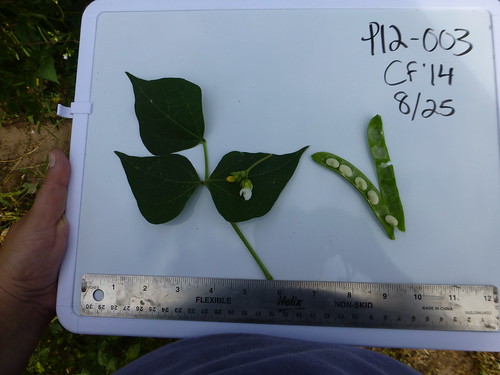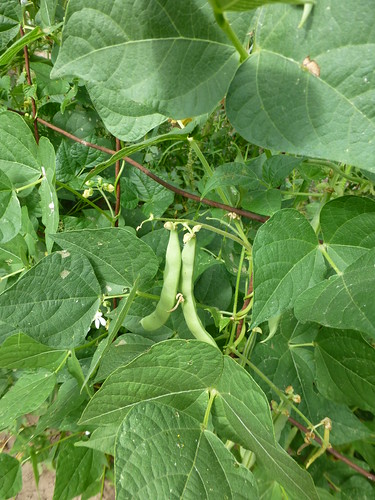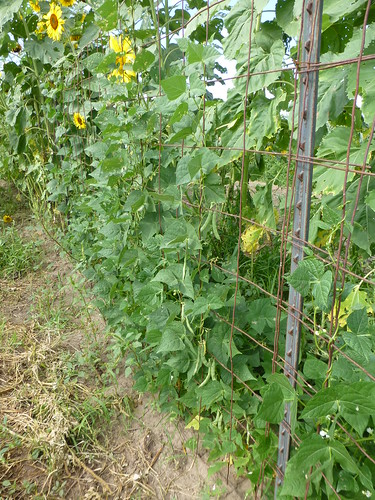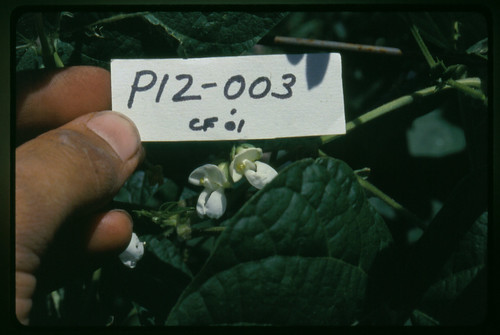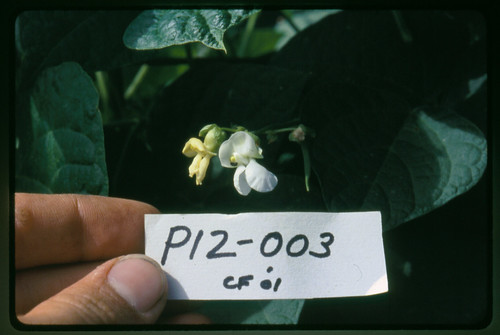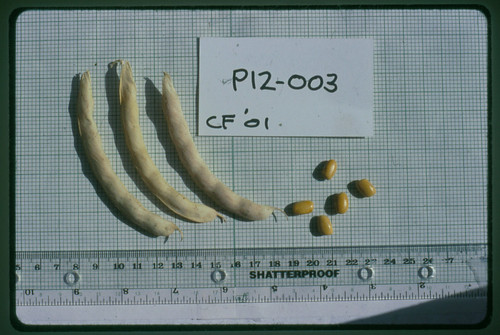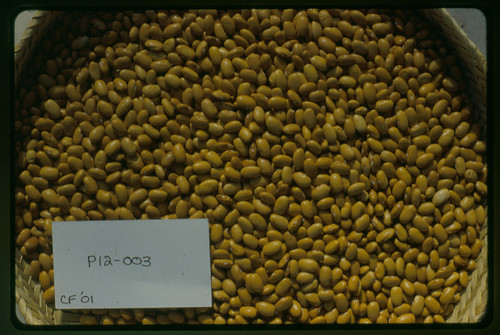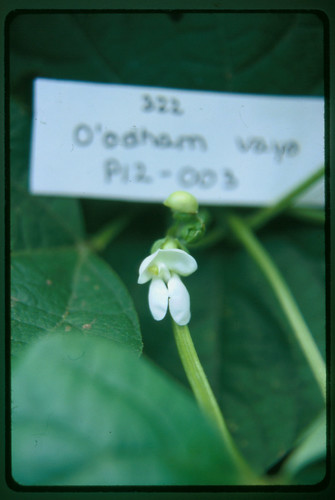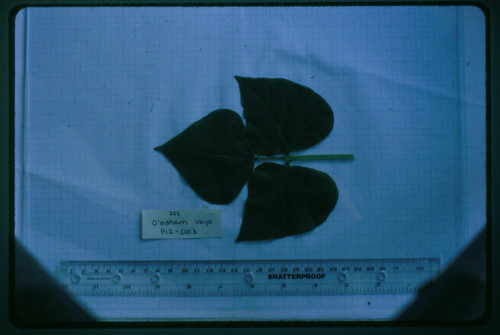ADAPTS
the Adaptive Drylands Agriculture Portal for The Southwest
P12-003
Collection | Availability | Map | Climate | Photographs | Observations | Cultivation & Seed Saving | Feedback
Basic Collection Information and Status
Common Bean (Phaseolus vulgaris, Fabaceae)
Cultural Affiliation Tohono O'odhamCollection Site Arizona, United States (latitude: 32°; altitude: 1,700 ft / 500 m)
Collection Year 1982
Accession Status Active
Catalog Information and Instructions
Tohono O'odham Vayo AmarilloPC131
Large gold bean from the Arizona/Sonora border region. A Mexican bean introduced to the Tohono O'odham. Sweet and creamy pole bean.
View All 2 Accessions of Tohono O'odham Vayo Amarillo (PC131) (this will reset your search)
View All 2 Accessions of Tohono O'odham Vayo Amarillo (PC131) (this will reset your search)
Current availability of this variety is summarized below. We encourage the use of these seeds to benefit humanity and strive to facilitate access through a number of channels.
Online Order Native American Free Seed Community Seed Grants Bulk Seed Exchange ? Contact us for current availability.
Academic Researchers ? If you are an academic researcher with an interest in this accession, please get in touch with us. We encourage use of the seeds for appropriate research applications and are committed to protecting the rights of the people and cultures who developed and maintained this diversity and to its continued availability.
Note: Seeds are distributed on a variety-by-variety basis, rather than accession-by-accession. As there are multiple accessions of this variety, please contact us if you need seeds of this specific accession.
Collection Site
The circle in the map below shows the area where this accession was collected (why isn't the precise locality shown
?Precise collection localities are hidden in order to protect the privacy of the original donors of the seeds in the NS/S collection.
). You have not specified a reference site, but you may specify one and rerun your search.The graphs below summarize aspects of the climate for this accession's collection site. You have not specified a reference site, but you may specify one and rerun your search.
Photographs
The Native Seeds/SEARCH digital photo collection for this accession is provided below.
image hosting provided by Flickr — all photos © Native Seeds/SEARCH — please contact us for permission to useCharacterization and Evaluation
The table below lists observations of this accession's characteristics (why are characters sometimes listed more than once
?For some accessions, observations of a particular trait have been recorded over more than one season or location; these are indicated by the different values in the Lot column.
).| Character | Observation | Lot, Frequency and Comments | Character Description (Source and Code) |
|---|---|---|---|
| 100 seed weight (primary) | 22.68 g | lot: CF '01 | (IPGRI 6.3.3) |
| darker seed color (primary) | Brown (pale to dark) | lot: CF '01 | (IPGRI 4.3.2: 2) |
| days to 50% flower | 60 | lot: CF '01 | Days from planting to 50% flower (IPGRI 4.2.2) |
| days to first flower | 44 | lot: CF '01 | Days from planting to first flower |
| days to greenbean | 96 | lot: CF '01 | Days from planting to greenbean. |
| days to maturity | 129 | lot: CF '01 | Days from planting to maturity (IPGRI 6.1.7) |
| leaf persistence | Intermediate | lot: CF '01 | When 90% of pods in plot are dry. (IPGRI 6.1.8: 5) |
| leaflet length | 8.9 cm | lot: CF '01 | Measured on terminal leaflet of third trifoliate leaf from pulvinus to leaf tip on plants grown under field conditions (IPGRI 4.1.1) |
| leaflet shape | Triangular-quadrangular-round | lot: CF '01 | Of terminal leaflet of third trifoliate leaf. (IPGRI 6.1.6: 1-2-3) |
| lighter seed color (primary) | Non-applicable | lot: CF '01 | (IPGRI 4.3.3: 0) |
| note | Slightly lighter, less shiny, and more veiny than tara. amarillo type | lot: CF '01 | |
| number of seeds per pod | 6.7 | lot: CF '01 | Average number of seeds from one pod selected from 10 plants. (IPGRI 6.3.1) |
| plant type | Indeterminate prostrate or vining but not climbing, to indeterminate climbing | lot: CF '01 | Describes final architecture of plant through interaction of many characters: terminal meristem growth, number of nodes on the stem, internode length, climbing ability, branching pattern. (GRIN HAB) |
| pod color immature | Normal green | lot: CF '01 | From fully expanded immature pod. (IPGRI 4.2.6: 7) |
| pod color mature | Pale yellow with colored mottling or stripes, yellow | lot: CF '01 | (IPGRI 4.2.11: 5,4) |
| pod cross section | Pear shaped | lot: CF '01 | From fully expanded immature pod. (IPGRI 4.2.8: 2) |
| pod curvature | Slightly curved | lot: CF '01 | Of fully expanded immature pod. (IPGRI 4.2.9: 5) |
| pod length | 10.9 cm | lot: CF '01 | Average length of the largest fuly expanded immature pods from 10 random normal plants. (IPGRI 4.2.7) |
| pod position | Combination of base, center and top | lot: CF '01 | (IPGRI 6.2.12: 4) |
| pod suture string | Few strings | lot: CF '01 | (IPGRI 4.2.10: 3) |
| pod wall fiber | Moderately shattering | lot: CF '01 | (IPGRI 4.2.12: 6) |
| relative abundance of primary seed type | 1 | lot: CF '01 | |
| seed brilliance (primary) | Medium | lot: CF '01 | (IPGRI 4.3.4: 5) |
| seed shape (primary) | Ovalââ¬âcuboid | lot: CF '01 | Taken from middle of pod. (IPGRI 4.3.5: 2-3) |
| seedcoat pattern (primary) | Absent | lot: CF '01 | (IPGRI 4.3.1: 0) |
| standard color | White | lot: CF '01 | In freshly opened flowers; the colors of freshly opened flowers are highly changeable after opening (IPGRI 4.2.4: 1) |
| style protrusion | Not protruding | lot: CF '01 | Protursion of style outside of keel. (IPGRI 6.2.7: 0) |
| taste of greenbean | Moderate | lot: CF '01 | |
| wing color | White | lot: CF '01 | In freshly opened flowers. (IPGRI 4.2.5: 1) |
| Common Bean Introduction | Cultivation Instructions | Seed Saving Instructions |
|---|---|---|
| Common beans are a diverse and important crop to Native American farmers throughout the Southwest. They are eaten young as green beans or dried and shelled. Plants can be bush, semi-pole, or pole. | Beans need warm soil for best germination. Plant seeds in spring or with summer rains about 1" deep and 6" apart. If beans need a trellis, try intercropping with corn or sorghum. | An annual that is generally self-pollinating, but can cross with other plants. Dried pods can be harvested throughout the growing season, or harvest whole plants. Separate varieties by 10 ft (3 m). |
If you have questions or feedback about this accession or the ADAPTS platform in general, please contact us.
